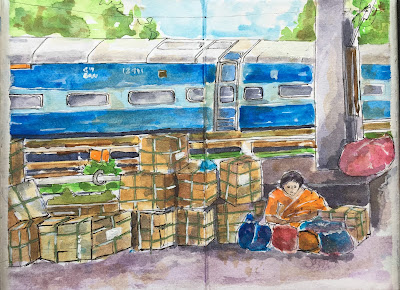Ironing the Wrinkles Out watercolor and ink by Meera Rao
India Art Journal 2015
I have sketched a
neighbourhood ironing lady before in 2013 and
a young boy ironing in 2012. This man had his 'shop' in a tiny little structure with a board to iron on and a shelf to stack up the finished items. There was a small tin box outside the shack where he was tending coals for the iron. All are enterprising people who fill a heavy iron with hot coals and iron out the wrinkles from shirts, pants, kids uniforms and ladies sarees to make a living. They pick up the laundered clothes from their customers and drop them off later crisply ironed, folded and ready to wear. Most of the vendors keep a rotating schedule of certain days and times during the week in a couple different neighborhoods. They have bare bones set up and work diligently. The young lady had proudly told me how careful she is to avoid any burn holes from hot coals in the clothes she is ironing.
For many among us ironing is a dreaded chore but it is 'work' for these people. And to Pablo Naruda, it is poetry :
In Praise of Ironing
by Pablo Neruda
translated by Alastair Reid
Poetry is pure white.
It emerges from water covered with drops,
is wrinkled, all in a heap.
It has to be spread out, the skin of this planet,
has to be ironed out, the sea's whiteness;
and the hands keep moving, moving,
the holy surfaces are smoothed out,
and that is how things are accomplished.
Every day, hands are creating the world,
fire is married to steel,
and canvas, linen, and cotton come back
from the skirmishings of the laundries,
and out of light a dove is born -
pure innocence returns out of the swirl.
Ironing the Wrinkles Out 5.5x8" watercolor and ink on 140 lb Strathmore visual Journal









